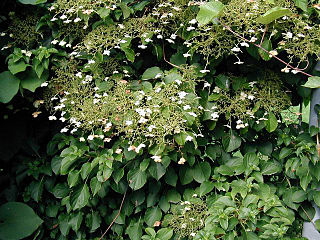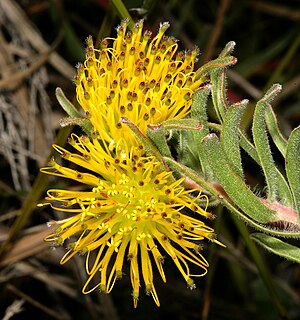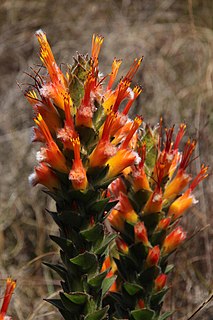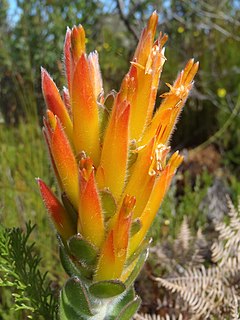
Acer circinatum, the vine maple, is a species of maple native to western North America, from southwest British Columbia to northern California, usually within 300 kilometres (190 mi) of the Pacific Ocean coast, found along the Columbia Gorge and Coastal Forest. It belongs to the Palmatum group of maple trees native to East Asia with its closest relatives being the Acer japonicum and Acer pseudosieboldianum. It can be difficult to distinguish from these species in cultivation. It is the only member of the Palmatum group that resides outside of Asia.

Acer ginnala, the Amur maple, is a plant species with woody stems native to northeastern Asia from easternmost Mongolia east to Korea and Japan, and north to the Russian Far East in the Amur River valley. It is a small maple with deciduous leaves that is sometimes grown as a garden subject or boulevard tree.

Hydrangea petiolaris, a climbing hydrangea, is a species of flowering plant in the family Hydrangeaceae native to the woodlands of Japan, the Korean peninsula, and on Sakhalin island of easternmost Siberia in the Russian Far East.

Mimetes arboreus, or Kogelberg pagoda, is an evergreen, upright large shrub or small tree of 2–6 m (6½–20 ft) high in the family Proteaceae. It grows from a thick trunk with a smooth grey bark that branches at ½–1 m (1½–3 ft) above the ground. It has silvery, lance-shaped, pointy leaves of 5–8¼ cm (2.0–3.3 in) long and ¾–3¼ cm (0.3–1.3 in) wide, at an upward angle and overlapping each other. The inflorescences are set just below the top of the branches, are cylinder-shaped, 8–10 cm in diameter, topped by a crest of more or less horizontal pinkish or reddish tinged leaves. It consists of several flower heads in the axils of pinkish orange leaves that form a hood shielding the underlying flower head. Each flower head contains eight to thirteen individual flowers, with bright red styles and grey silky perianth lobes. It is endemic to the Fynbos ecoregion of South Africa, being confined to the Kogelberg mountain range.

Lomatia ferruginea, commonly known as fuinque, is a small evergreen tree in the family Proteaceae.

Olearia erubescens, commonly known as moth daisy-bush or pink-tip daisy-bush, is a species of flowering plant in the family Asteraceae. It is a shrub with stiff, prickly leaves and white "daisy" flowers, growing up to 2 metres high.

Leucospermum reflexum is a large rounded shrub that is assigned to the family Proteaceae. It grows from a single trunk and its branches are covered in smooth grey bark. It has small elliptic to inverted lance-shaped greyish leaves of only 2–5½ cm (0.8–2.2 in) long. The heads consist of mostly dark orange 4-merous flowers, from which long, identically colored styles emerge, which are directed straight down during flowering. It is called rocket pincushion or skyrocket leucospermum in English and perdekop in Afrikaans. It flowers from the end of August to December. It is an endemic species that can only be found in the southwest of South Africa.

Dolichandra unguis-cati, commonly known as cats claw creeper, funnel creeper, or cat's claw trumpet, is a rapidly growing climbing vine belonging to the family Bignoniaceae.

Hibbertia miniata, commonly known as orange flower, is a small shrub in the family Dilleniaceae and is endemic to Western Australia.

Leucospermum erubescens is an evergreen shrub of up to 2 m high, with hairless, lancet-shaped to oval leaves with three to seven teeth near the tip of 7–8½ cm long and 1–2 cm wide, slightly asymmetric, oval flower heads of 5–6½ cm in diameter, and usually with four to eight clustered near the end of the branches, with initially yellow flowers, that change to deep crimson, from which long styles stick out, giving the flowerhead as a whole the appearance of a pincushion. It is called orange flame pincushion in English and oranjevlamspeldekussing in Afrikaans. It can be found in South Africa. Flowers may be found between August and January.

Leucospermum praemorsum is an evergreen shrub or small tree of up to 5 m (16 ft) high. It has hairless oblong to inverted lance-shaped leaves of 7–8 cm long and 1½–2 cm wide, tapering at their base to a stalk of up to 2 cm long, and cut-off at the tip with three to five teeth, and pale carmine, inverted cone-shaped flower heads. From the center of the flowers emerge long initially orange, later deep crimson styles that jointly give the impression of a pincushion. It is called Nardouw fountain-pincushion or Nardouw pincushion in English and Nardouwluisiesbos in Afrikaans. Flower heads can be found off and on throughout the year, particularly in older plants, with a peak between July and December. It is an endemic species that can only be found in part of the Western Cape province of South Africa.

Leucospermum saxosum is an upright evergreen shrub of up to 2 m (6.6 ft) high, that is assigned to the family Proteaceae. It has lance-shaped, leathery leaves and egg-shaped flower heads of about 5 cm (2.0 in) in diameter, with initially yellow-orange flowers, later turning crimson, from which long styles stick out, giving the flower head the appearance of a pincushion. It is called escarpment pincushion in English. It grows on quartzite soils in the mountains on the Zimbabwe-Mozambique border and in eastern Transvaal.

Leucospermum harpagonatum is an evergreen trailing shrublet with leathery, line-shaped, upright leaves and small heads with eight to ten cream, later carmine-colored, strongly incurved flowers assigned to the family Proteaceae. It is reminiscent of the hottentot fig without its flowers. It is called McGregor pincushion in English and flowers from late August till early November. It is critically endangered and occurs only in a very small area in the Western Cape province, South Africa.

Leucospermum gueinzii is an evergreen, upright shrub of 2–3 m (6–9 ft) high from the family Proteaceae. It has pointy lance-shaped to elliptic, eventually hairless, mostly entire leaves and egg-shaped, later flatter flower heads of about 12 cm in diameter, containing initially deep orange, later crimson flowers. From the center of each flower emerges a long style with a thickened tip, giving the entire head the appearance of a pincushion. Its flowers can be found between August and December. It is called kloof fountain-pincushion or shorter kloof pincushion in English. This is an endemic species restricted to a very small area near the south coast of the Western Cape province in South Africa.
Leucospermum profugum is an evergreen shrub of up to 8 m (25 ft) in diameter, with at base leafless main branches, that trail over the surrounding vegetation and rock, from the family Proteaceae. It has hairless and leathery inverted lance-shaped to oblong leaves tipped with mostly three or four teeth and flattened egg-shaped flowerheads of 9–12 cm (3.6–4.8 in) in diameter, that consist of initially yellowish orange flowers that later changing to salmon pink. From the center of the flowers emerge almost straight styles that jointly give the impression of a pincushion. It is called Piketberg pincushion in English. Flower heads can be found between late September and December. It is an endangered species, only known from three close locations in the Western Cape province of South Africa.

Leucospermum spathulatum is an evergreen, spreading and mat-forming shrub, that has been assigned to the family Proteaceae. It has inverted egg-shaped to spade-shaped mostly greyish softly hairy leaves, mostly without teeth and flattened globe-shapec flower heads of 5–7 cm (2.0–2.8 in) across, consisting of deep orange to crimson flowers, the bud and the style curving toward the center. It can be found in the Western Cape province of South Africa. The common name in English is Cederberg pincushion. It flowers between September and January, with a peak at the end of October.

Leucospermum gracile is a low spreading shrub of 30–40 cm high and forms open mats of 1½ m (5 ft) in diameter, from the family Proteaceae. It has reddish flowering stems, oblong to linear leaves of 2–4½ cm (0.8–1.8 in) long and 2–5 mm (0.08–0.20 in) wide, with one or three teeth. The initially yellow, later orange flower heads of 2½–3 cm (1.0–1.2 in) in diameter are flat-topped. The flower heads occur from July to October. From the flowers occur long styles with a slightly thicker tip, which together give the impression of a pincushion. It is called Hermanus pincushion in English. It naturally occurs in fynbos in the southern mountains of the Western Cape province of South Africa.

Mimetes capitulatus is an evergreen, upright, rounded shrub of about 2 m (7 ft) high, from the family Proteaceae. It has geyish green, lance- to egg-shaped leaves ending in a thickened tip. The flower heads and subtending leaves form a cylindric inflorescence, topped by ordinary, more or less upright leaves. Each primarily orange flowerhead contains 10–13 flowers with conspicuously scarlet styles, yellow under the narrow hourglass-like pollen presenter at its tip. Flowers can usually be found from mid-June till December, peaking in August. It is called conical pagoda in English and skraalstompie in Afrikaans.

Mimetes splendidus or splendid pagoda is an evergreen, rather sparsely branching, upright shrub of up to 2½ m (8 ft) high from the family Proteaceae. It has broadly lance-shaped to oval, silvery-hairy leaves with three or four teeth crowded at the tip. It has cylinder-shaped inflorescences that consists of many heads, each containing eleven to thirteen flowers, in the axils of the highest leaves. These leaves form a hood over a lower flowerhead and are flushed orangy pink. It flowers during winter, from early May to September. It is an endemic species that is restricted to the south face of the coastal mountains of the Western Cape province of South Africa.

Mimetes pauciflorus, the three-flowered pagoda, is an evergreen, shyly branching, upright shrub of 2–4 (6½–13 ft) high, from the family Proteaceae. It has narrowly to broadly oval leaves of 2½–4 cm (1.0–1.6 in) long and ¾–2 cm (0.3–0.8 in) wide, on the upper parts of the branches, the lower parts leafless with a reddish brown bark. The inflorescences at the top of the shoots are cylinder-shaped, 10–40 cm (4–16 in) long and contain forty to one hundred twenty densely crowded flower heads, at a steep upward angle, hiding a crest of very small, almost vertical leaves. The flower heads each consist of three, rarely four individual flowers. The flowers are tightly enclosed by four or five orange-yellow, fleshy, pointy, lance-shaped involucral bracts, and three orange-yellow, 4–5½ cm (1.6–2.4 in) long bracteoles. It grows on always moist, south-facing slopes in the southern coastal mountains of South Africa. Flowers can be found from August to November, with a peak in September.




















